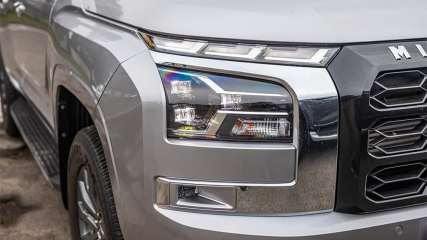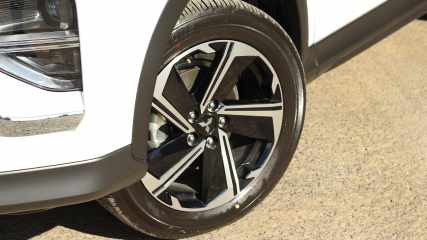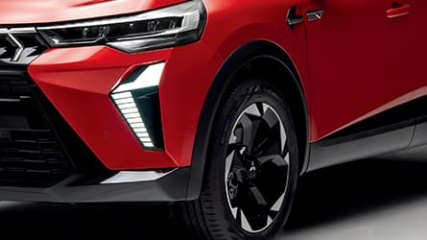1988 Mitsubishi Starwagon Reviews
You'll find all our 1988 Mitsubishi Starwagon reviews right here. 1988 Mitsubishi Starwagon prices range from $1,980 for the Starwagon Gl to $4,070 for the Starwagon Eci 4x4.
Our reviews offer detailed analysis of the 's features, design, practicality, fuel consumption, engine and transmission, safety, ownership and what it's like to drive.
The most recent reviews sit up the top of the page, but if you're looking for an older model year or shopping for a used car, scroll down to find Mitsubishi dating back as far as 1986.
Or, if you just want to read the latest news about the Mitsubishi Starwagon, you'll find it all here.
Mitsubishi Reviews and News
_0.jpg)
Resale kings! The surprising utes that hold their value best: Exclusive report reveals the winners and losers from Ford Ranger and Toyota HiLux to GWM Ute and LDV T60 | Analysis
Read the article
By Laura Berry · 15 Feb 2025
Utes are Australia’s most popular type of vehicle, but which models offer the best resale value when the time comes to selling them? CarsGuide’s analytics team crunched the numbers so that we could bring you this exclusive report.
.jpg)
Toyota RAV4 rival in for an upgrade: 2026 Mitsubishi Outlander timing confirmed for Australia but when will the updated petrol and plug-in hybrid BYD Sealion 6 SUV rival go on sale?
Read the article
By Chris Thompson · 12 Feb 2025
Mitsubishi has updated the petrol version of the Outlander SUV, joining the earlier update applied to the plug-in hybrid version last year.
.jpg)
Aussie electric car breakthrough! How this game-changing technology could transform your Mitsubishi Outlander PHEV and Eclipse Cross plug-in hybrid into a energy bill cutting beast
Read the article
By Dom Tripolone · 08 Feb 2025
Electric car sales plummeted in January in Australia and are stagnating in most major car markets, but help is on the way.

Special new ute arrives in Australia: 2025 Mitsubishi Triton GSR special edition announced to take on the Isuzu D-Max X-Terrain, Ford Ranger Wildtrak and Toyota HiLux
Read the article
By Dom Tripolone · 03 Feb 2025
Mitsubishi is adding some variety to its Triton line-up.The Japanese brand has announced a new Triton GSR special edition, which brings some cosmetic and tech advancements.It is priced from $63,140 (before on-road costs), which is slightly cheaper than the existing GSR.Mitsubishi Australia’s head of product, Bruce Hampel, said the new special edition was based on feedback from dealers and customers.“We saw an opportunity to enhance customer choice for the Triton GSR, with a more rugged appearance. The GSR Special Edition combines the GSR’s impressive specification with a distinctively-themed exterior package that further broadens its appeal,” said Hampel.It has a graphite grey grille with embossed Mitsubishi lettering.Mitsubishi has installed a black sports bar and the regular GSR’s fender flares have been removed, which the brand said opens up the GSR to be fitted with more accessories.The special edition also has the brand’s improved safety tech that allows for adaptive cruise control to be engaged up until the vehicle comes to a complete stop rather than shutting off at 25km/h or lower.The Triton GSR special edition, and all Mitsubishis are covered with the brand’s conditional 10 year/200,000km warranty. Owners must service their vehicle at a dealership every time to maintain the long warranty, otherwise it reverts to five years/100,000km.Mitsubishi has a 10-year capped-priced servicing program.The Mitsubishi Triton is one of the most popular utes on sale in Australia with close to 15,000 units being sold in 2024.A new version arrived early in 2024 and brought it up to speed with the rest of the class with a braked towing capacity of 3500kg. The previous version tapped out at 3000kg.It is powered by a 2.4-litre twin-turbocharged four-cylinder diesel engine that makes 150kW and 470Nm, paired with a six-speed automatic and four-wheel drive.There is a strong chance the Triton could use plug-in hybrid power in the near future to boost performance and reduce fuel use. Its alliance partner, Nissan, has confirmed it will use Mitsubishi’s plug-in hybrid power in its next-gen Navara ute due in 2026.A hardcore Ralliart off-road version has also been mooted by the brand, which would give it a genuine rival to the class leading Ford Ranger Raptor.

Replacement for Mitsubishi's axed SUV confirmed? 2026 Mitsubishi Eclipse Cross could be a Nissan Leaf, Nissan Ariya, Renault Megane E-Tech based electric SUV: Report
Read the article
By Dom Tripolone · 30 Jan 2025
Mitsubishi is preparing its first next-generation electric car.

If you want a plug-in hybrid, buy it soon: The FBT exemption on plug-in hybrid cars is ending, how will that affect demand for popular PHEV cars such as the 2025 BYD Shark 6 ute, Sealion 6, Mitsubishi Outlander and GWM Haval H6 GT?
Read the article
By Samuel Irvine · 28 Jan 2025
Plug-in hybrid (PHEV) vehicle sales are surging, but the federal government is about to put a roadblock in the path of these petrol-electric machines.

All the cars axed by Australia's rule changes and surprising models like the Toyota LandCruiser 70 Series, Nissan Patrol, Toyota Fortuner and LDV T60 that are prepared for ADR 98/00
Read the article
By John Law · 27 Jan 2025
New Australian Design Rules (ADRs) will begin to bite from March 1, 2025, requiring all new vehicles to be sold with auto emergency braking (AEB) systems. The rules mean major withdrawals from the Australian new-car market but they aren’t quite as widespread as you might imagine, with some manufacturers putting in the effort to keep their cars on the right side of the law. Falling in line with United Nations safety protocols, ADR 98/00 — Advanced Emergency Braking for Passenger Vehicles and Light Goods Vehicles requires the fitment of AEB, a life-saving technology that can automatically apply the brakes if a car senses an impending crash. These systems have various levels of effectiveness but the latest rule change is concerned with being able to detect other cars on the road. The systems must function at least between 10-60km/h and be able to bring the vehicle to a complete stop on a dry road from 40km/h. They must also switch on every time the car is started. This applied to new models of passenger car, light and medium commercial vehicles from March 1, 2023 and will cover all new vehicles imported into Australia from March 1.Mitsubishi is the hardest hit by the new rules, no longer able to sell the Pajero Sport off-road SUV or Eclipse Cross small SUV. The long-running ASX is also affected but Mitsubishi’s small SUV will be replaced by a new model this year.Next casualty is the cut-price Suzuki Ignis, which is not fitted with the technology. A new model, the Fronx, will replace it but probably not at its bargain price. Entry-level Vitaras will also be affected, though the brand did not respond to our query. The Porsche 718 would have been hit by the rule change, but production ceased in September with a new electric generation coming equipped with AEB. Another affordable brand slugged with the need for AEB is LDV, its cheap V80 large van is not equipped with the technology but, like the Porsche, production ended last year and all that’s left is existing stock. The entry trim T60 ute and all G10 van trims also lack AEB. CarsGuide was informed by a spokesperson that both “will meet the upcoming requirements for ADR 98/00”, with more news to share in the coming months. The Toyota Granvia people mover has also been given the chop. Onto the, perhaps unlikely, candidates that are equipped with AEB. Despite their age, these vehicles remain important sellers for carmakers, so it was clearly worth investing.There is none older than the Toyota LandCruiser 70 Series, over 40 years old its mid-life crisis (or glow-up) saw Toyota add crucial AEB including pedestrian, cyclist and motorcycle detection. Toyota also, a little sneakily, bumped the GVM beyond 3500kg to 3510kg in 2023. The value of this is that the 70 Series becomes reclassified as a medium goods vehicle, allowing it to dodge the latest side impact regulations that would’ve seen an imminent sales stop. The Toyota Fortuner, current HiLux and GR86 manual are all equipped with AEB that permit sale in Australia up to, and beyond, 2026.Another ageing model due for replacement is the Nissan Patrol, though the new version is not due until 2026 the Y62’s many life-cycle updates saw ‘Intelligent Emergency Braking’, an AEB system that can detect cars and pedestrians, way back in 2019.Also worth noting is the British Ineos Grenadier off-roader, the first batch does not have AEB. Cheekily, orders opened in May 2022 (before the mandate for all-new models) but customers didn’t receive cars in bulk until the first quarter of 2023, and Australian media only sampled the cars in December of that year. CarsGuide understands that all Grenadiers and Quartermasters will be equipped with AEB from March onwards.The Australian Government has launched a review into ADRs going forwards now there is no longer local manufacturing to legislate (and protect). The next big active safety ADR change (revised as ADR 98/01) is due in August 2026, when all cars sold must have AEB systems that can intervene if a pedestrian is detected in the path of a vehicle. Some carmakers, including Nissan and Mitsubishi, have called for this to better align Australia’s laws with Europe, Japan and the USA promoting greater affordability and fast-tracking of more efficient models.

'We've got plenty of sticks, but not enough carrots': Mitsubishi Australia calls for help to allow it to sell more plug-in hybrid Outlanders and bring in electric cars quicker
Read the article
By Dom Tripolone · 25 Jan 2025
Mitsubishi Australia's boss is calling for the federal government to do more to help carmakers meet tough new emissions regulations.The New Vehicle Efficiency Standard (NVES) came into effect this year. The new legislation penalises car makers for every gram of CO2 a vehicle emits over a certain threshold. The penalty is applied to every offending vehicle sold and this threshold gets lower every year until 2030.Carmakers can offset the sales of high-polluting vehicles with the sale of electric cars and plug-in hybrids (PHEV).Australia is one of the last mature car markets to have an official emissions scheme, so the concept is nothing new to global carmakers.The new NVES will hit several big name Japanese brands hard in the next few years, with many slow to roll out electric cars.Head of Mitsubishi Australia Shaun Westcott wouldn't divulge if it would cop penalties in the next few years but said: "There are very few of the traditional car companies who are going to avoid some form of penalty".He said the company will do as much as it can to mitigate penalties and to push its PHEVs as hard as it can. He said the company is all for the NVES but has called for the government to help it sell more of the low emissions vehicles.“Government has put penalties in place for industry, so we’ve got plenty of sticks, and we will do the right thing, but the problem is we need a few carrots. We need incentives to drive consumer behaviour.”Westcott pointed to new research from Deloitte that showed the biggest concern people had about EVs was range anxiety and lack of charging infrastructure.So for people to overcome these hurdles they need some sort of incentive to compensate for the inconvenience, he said.“We’ve got plenty of sticks, but not enough carrots,” he reiterated.Mitsubishi is without any electric cars on sale in Australia. It sells two plug-in hybrids — the Outlander and Eclipse Cross — but the Eclipse Cross will be axed from the local line-up this year as it does not meet new Australian design Rules about auto emergency braking. The brand will not immediately replace the model either, meaning it will be down to one plug-in hybrid model in its entire range.The Outlander PHEV makes up about one quarter of sales for the large SUV, which might not be enough to offset sales of its other vehicles.The brand also lacks conventional plugless hybrids in its current line-up, though that might change with the arrival of the updated ASX compact SUV later this year.Plug-in hybrids have substantially bigger batteries than normal hybrids, and much more powerful motors, which allow them to be driven a decent distance in electric-only mode. The current Mitsubishi Outlander PHEV can travel up to 80km and the upgraded version due soon is likely to lift this to about 100km.Westcott said Mitsubishi’s research had shown most of its PHEV customers drive mostly in electric mode all the time.This shows they are a great transition vehicle to electric cars and they can make a meaningful reduction to tailpipe emissions today.Mitsubishi Australia's Government Relations Manager Yarik Turianskyi said the company had made several proposals to the government about how they could incentivise PHEV sales."We're also trying to propose some alternative mechanisms. It could be an upfront rebate, it could be the removal of GST. Because we believe that just as the sales are going up, you don't want to shock the market, remove these incentives, and then all of a sudden the market will go down. Because PHEV sales will be able to produce emissions reduction right here and right now ... so let's keep supporting it," he said.Mitsubishi also wants the government to allow electric vehicles sold in regions such as Europe and Japan to be allowed in without having to meet some of our unique ADR requirments. Mitsubishi has the potential to leverage electric vehicle technology from its current alliance partners Nissan and Renault.Nissan has confirmed Mitsubishi’s plug-in hybrid technology will feature in the next-generation Navara ute, so a quid pro quo could deliver a Mitsubishi electric car based on the Ariya mid-size electric SUV on coming compact Leaf SUV.That Navara news also suggests a plug-in hybrid version of the Triton isn't far away, but this is still unconfirmed by Mitsubishi.For now, Mitsubishi is mum on any electric cars coming Down Under but its global Momentum 2030 plan puts electrification at its core, with a stream of new models due over the course of the decade to help alleviate these pain points.

'We plan to be here for another 40 years': How Mitsubishi plans to be a big player in the face of new competition such as BYD Sealion 6 and Shark 6 and without the Pajero Sport and Eclipse Cross and likely pricier ASX SUVs
Read the article
By Dom Tripolone · 23 Jan 2025
Australia’s new car landscape is about to change dramatically, according to head of Mitsubishi Australia Shaun Westcott.

Can't wait for Prado? From the all-new Mitsubishi Pajero to the BYD Fang Cheng Bao 5, these are the tough off-road 4WDs coming to Australia ready to take on Toyota
Read the article
By Andrew Chesterton · 21 Jan 2025
The all-new Toyota Prado has taken Australia's 4WD market by storm, with pent-up demand for a new model delivering some 17,000 orders by the end of 2024, with the brand anticipating some 27,000 deliveries in its first 12 months of sale.




